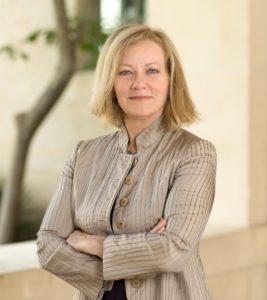
Dr. Michelle Addington, Dean & Henry M. Rockwell Chair, The University of Texas at Austin School of Architecture
Critical Questions for the Future of Sustainable Design
Abstract: As we accelerate ever faster to climate change’s warming limit of 2° C, after having already passed the 400 ppm CO2 threshold a few years ago, we have not witnessed a meaningful reduction in the energy use of the building sector. Unquestionably, there have been enormous strides in analysis and simulation, in the development of new technologies and materials, and in the integration of multiple disciplines to bring unprecedented resources and knowledge to the design of the built environment. As much as these strides have advanced our field, they have not only been unable to match the continuing rise in emissions, but they have not aggressively addressed the impacts of the rapid urban growth taking place globally. If our methods, materials and tools have improved, have we perhaps missed the mark on our questions?
Bio: Michelle Addington is Dean of The University of Texas at Austin School of Architecture, where she holds the Henry M. Rockwell Chair in Architecture. Formerly, she served as Gerald Hines Chair in Sustainable Architectural Design at the Yale University School of Architecture and was jointly appointed as a Professor at the Yale University School of Forestry and Environmental Studies. Prior to teaching at Yale, she taught at the Harvard University Graduate School of Design, the Technical University of Munich, Temple University and Philadelphia University.
Originally educated as a mechanical/nuclear engineer, Addington worked for several years as an engineer at NASA/Goddard Space Flight Center and for E.I DuPont de Nemours before she studied architecture. Her teaching, research, and professional work span across these disciplines with the overarching objective of determining strategic intersections between the optimal domains of physical phenomena with the practical domains of spatial, geo-political, economic, and cultural systems. Her books, chapters, essays, journal papers, and articles address topics ranging from fluid mechanics to the History of Technology to smart materials, and she has consulted on projects as diverse as the Sistine Chapel and Amazon rain forest.
Addington received a B.S.M.E. from Tulane University, a B.Arch from Temple University, and M.Des.S. and Dr.Des degrees from Harvard University. She also holds an honorary M.A. from Yale University. In 2009, she was selected as one of the country’s top ten faculty in architecture by Architect Magazine, and, in 2014, she was named as one of Connecticut’s “Women of Innovation.”

Dr. Jan Carmeliet, Professor, Chair of Building Physics, Department of Mechanical Engineering, ETH Zurich
Multiphysics Modeling of Materials, Assemblies, Buildings and Cities
Abstract: There is growing evidence that heat waves are becoming more frequent under increased greenhouse forcing, associated with higher daytime temperatures and reduced night-time cooling, which might exceed the limits of thermoregulation of the human body and affect dramatically human health. Especially urban areas are affected, since these regions in addition experience an urban heat island (UHI) effect characterized by higher air temperatures compared to the surrounding rural environment. A necessary breakthrough is a shift away from a fragmented approach towards an integrated multiscale urban climate analysis. This type of research is a rather new domain of research and might be based on an all-physics understanding and modeling of the urban climate ranging from the scales of material and buildings, to the scales of a group of several buildings, street canyons, neighbourhoods, cities and urban regions, referred to as multiscale building physics. To adequately cover global and local urban heat island effect, regional and mesoscale climate analyses have to be downscaled to sub-kilometer resolution and linked with urban climate models at neighborhood and street canyon scales. Such a multiscale urban climate model allows to analyze the influence of urban and building parameters on thermal comfort and the building cooling demand. The importance of accounting for the local urban climate when quantifying the space cooling demands of buildings in an urban environment is demonstrated. The heat-moisture transport model for building materials allows the design of new building materials, which can help in the mitigation of local heat islands. With respect to evaporative cooling materials, we need to optimize their water retention and evaporative cooling by tailoring their pore structure. The understanding and information obtained from pore-scale investigations enables to understand macro-scale transport processes, and enabling us to explore the potential of new evaporative cooling materials at local urban scale.
Bio: Since June 2008, Jan Carmeliet is full professor at the Chair of Building Physics at the department of Mechanical Engineering at ETH Zürich and head of the Laboratory of Multiscale studies in Building Physics of EMPA (until 01.04.2017), Dübendorf (Swiss Federal Laboratories for Materials Science and Technology), Switzerland. Jan Carmeliet, graduated from the Katholieke Universiteit Leuven (K.U.Leuven) in Engineering Architecture, got his PhD in Civil Engineering at K.U.Leuven in 1992 and was postdoc a TU.Delft in 1993-1994. He has been Assistant (1998), Associate (2001) and Full professor (2004) at K.U.Leuven and part-time Professor at T.U.Eindhoven (2001-2008).
He was in 2007 on sabbatical leave at the University of Illinois at Urbana Champaign and at Los Alamos Governmental Laboratories. His research resulted until now in more than 245 scientific journal papers. His research interests concern multiscale behaviour of porous and granular materials and their fluid interactions, heat-air-moisture flow in the urban environment and multi-energy decentralized systems at building and urban scale. Research is based on advanced computational modelling (atomistic, molecular dynamics, discrete elements, lattice Boltzmann, CFD, FEM, energy-hub) and advanced experimental techniques (X-ray and Neutron Tomography, …) and time-resolved imaging in wind and water tunnels (PIV, LIF).
He is research councilor of the National Science Foundation Switzerland, expert of the Commission of Technology and Innovation Switzerland (CTI/engineering), director of the graduate program ‘master integrated building systems’ at ETHZ, and member of the Board of Energy Science Centre ETH Zürich. He was member of the research commission of ETH Zürich and of the scientific commission of the CCEM (Centre of Competence Energy and Mobility). He is very active in the SCCER (Swiss competence center energy research) FEEB&D (Future energy efficient buildings and districts) phase I (2014-2016) and phase II (2017-2020).
 Dr. Patricia J. Culligan, Robert A. W. and Christine S. Carlton Professor of Civil Engineering, Columbia University
Dr. Patricia J. Culligan, Robert A. W. and Christine S. Carlton Professor of Civil Engineering, Columbia University
Green Infrastructure and Urban Sustainability: Recent Advances and Future Challenges
Abstract: Although the majority of urban green infrastructure (GI) programs in the United States, and elsewhere, are being driven by stormwater management challenges arising as a result of the impervious nature of modern cities, GI is also believed to provide other benefits that enhance urban sustainability. This talk discusses the role that GI systems might play in urban climate adaptation strategies for cities like New York City, where increases in both temperature and precipitation are projected over the coming decades. Examples of work conducted by the author and colleagues in New York City to quantify the performance of urban GI will first be presented. This work includes monitoring efforts to understand how extensive green roofs retain rainfall, reduce surface temperatures and sequester carbon. Next, a discussion of the advantages that a distributed, or neighborhood level, GI system might bring to a climate adaptation strategy will be provided. The talk will then conclude with an outline of some of the future work that is needed to fully realize the potential of urban GI systems to address future climate change impacts.
Bio: Patricia J. Culligan is the Robert, A. W. and Christine S. Carlton Professor of Civil Engineering at Columbia University, where she served as the Founding Associate Director of Columbia University’s Data Science Institute and still serves as the Co-Director of the Earth Institute’s Urban Design Lab.
Dr. Culligan’s expertise lies in the field of geo-environmental engineering, with an emphasis on water resource management and issues related to urban and environmental sustainability. Her research group is currently active in investigating the opportunities for green infrastructure, social networks and advanced measurement & sensing technologies to improve the management of urban water, energy, and eco-system services in the face of rapid urbanization and climate change. She is one of the lead investigators of a $12 million research network sponsored by the National Science Foundation (NSF) to develop new models for urban infrastructure to make cities cleaner, healthier, and more enjoyable places to live.
Culligan has received numerous research and teaching awards for her academic contributions, including the National Science Foundation’s CAREER AWARD and Columbia University’s Presidential Teaching Award. She has also served on the Board of Governors of the Geo-Institute and the National Academies Nuclear and Radiation Studies Board, and has Chaired the National Academies Committee on Geological and Geotechnical Engineering. She is the author or co-author of more than 150 technical articles. Culligan received her BSc from Leeds University, England and her MPhil and PhD from Cambridge University, England.

Dr. Richard deDear, Professor & Director of Architectural & Building Science & Technology, Sydney School of Architecture, Design and Planning, University of Sydney
Dynamic Environment, Adaptive Comfort, and Cognitive Performance
Abstract: Since the invention of air conditioning over 100 years ago a central research challenge has been to define the indoor environmental temperatures best suited for occupants. The first scientific approach to this question was framed in terms of optimizing occupant thermal comfort, commonly expressed as a U-function, symmetrical around a single optimum temperature for any given combination of the remaining comfort parameters (ISO, 2005). The inescapable conclusion drawn from such logic in the minds of risk-averse design engineers is that the only strategy able to reliably deliver occupant comfort is HVAC applied to sealed-façade architecture.
A rigorous scientific rebuttal of the “single temperature optimum” model of comfort came 30 years after PMV/PPD was first floated (e.g. de Dear and Brager, 1998; 2001). Known as the adaptive comfort model, a clear implication is that passive design solutions are capable of delivering comfortable internal environments across a broad swathe of climate zones, throughout most if not all of the year. But recently the “single temperature optimum” model has resurfaced, this time with its justification shifting away from the thermal comfort requirements of occupants towards their cognitive performance.
Beyond the building science domain, in disciplines such as psychology and ergonomics, the prevailing wisdom regarding temperature effects on cognitive performance is an extended-U rather than an inverted U function. The gist of the model is that cognitive performance is relatively stable throughout the moderate temperature range, but it rapidly deteriorates at the boundaries of thermal acceptability where stress drains the performers’ attentional resources. The extended-Umodel has garnered broad acceptance across a range of disciplines with the notable exception of HVAC engineering and indoor air sciences. But the weight of research evidence tends to support the extended- rather than inverted-U model. In this paper, the arguments regarding thermal effects on cognitive performance are critically evaluated.
Bio: Over the last 35 years, Professor Richard de Dear has focused his research career on defining what occupants want and need from their built environments, and assessing the performance of buildings in terms of meeting those requirements. He is currently the most highly cited living researcher in the domain of thermal comfort, with over 250 peer-reviewed papers plus several monographs on the subject. Within that body of research, it is his adaptive model of thermal comfort that’s had the greatest impact, not just on the research community but also on the design and operation of actual buildings. De Dear’s adaptive model underpins the American Society of Heating and the Refrigerating and Air Conditioning Engineers’ thermal comfort standard, ASHRAE 55-2004, 2010, 2013, which in turn, informs several national thermal comfort standards around the world.

Dr. Yuguo Li, Professor, Head of Department of Mechanical Engineering, University of Hong Kong
The Physics in Natural Ventilation of Cities and Buildings
Abstract: Sixty percent of the world’s population – i.e. 4.3 billion people – live in Asia in just 30% of the world’s landmass. Asian cities in the so-called valeriepieris circle are mostly taller, denser, deeper and larger than those in the West, and the effects of building drag and urban heat island circulation are also stronger. The physics of urban climate in these large cities is complex, as a combined result of local circulation and synoptic winds modified by the mountainous topography and land/sea breeze, if any. Urban air pollution and warming in the rapidly urbanizing Asia have been a great challenge to mankind. Natural ventilation of a city refers to the penetration and distribution of rural air into an urban canopy layer. The weakened city ventilation has become one major reason for worsening urban warming and air pollution in cities. Two distinct situations need to be considered, i.e. when the synoptic wind is strong; and when the synoptic wind is weak respectively. For the former, designers are interested to manage city ventilation for removal of the urban heat, moisture and pollutant, or retain of urban heat and moisture. The latter become mostly the conditions for the worst urban extreme heat or haze scenarios to occur. Natural ventilation of a building refers to the introduction of outdoor air into a building by natural forces such as wind and buoyancy. High-rise buildings present an interesting challenge as the top of the building may be in the urban roughness layer or even beyond the atmosphere boundary layer. I shall attempt to review the status of our understanding of the physics in city ventilation under both strong and weak wind conditions, and discuss our recent findings on urban extreme high temperature event in June 2016 in Kowloon, the spread of SARS CoV virus when there is inversion, and the urban domes and their merging using simple theoretical estimates, water tank models, city scale CFD, and meso-scale WRF. Our work aims to establish the need and an approach for designing city climate and environment as for buildings, for example, designing building density and height in a city for better urban climate, and between-city distance needed to avoid regional haze formation.
Bio: Yuguo Li is a Professor and the Head of Department of Mechanical Engineering, the University of Hong Kong. Li was a Principal Research Scientist and the team leader of indoor environments at CSIRO Australia prior to 2000 when he joined the University. He studied at Shanghai Jiaotong University, Tsinghua University Royal Institute of Technology, Sweden.
His research interests are in building environment engineering. His current research topics include city climate, environment studies of infection and indoor air quality. His work led to the findings of the roles played by airflow in the 2003 Amoy Gardens SARS outbreak. He led and developed the 2009 WHO guidelines on natural ventilation. He has been leading two collaborative research grants in Hong Kong with one on ventilating a high-rise compact city and another on spread of virus in a large city. His work has also been supported by GRC GRF, RFCID, NSFC, WHO, Boeing and Microsoft. He was a guest/adjunct/visiting professor in Shanghai Jiaotong University, Aalborg University, Tianjin University, Technical University of Denmark, currently at Dalian University of Technology and Xi-An University of Architecture and Technology.
He currently also serves as President, Academy of Fellows of International Society of Indoor Air Quality (ISIAQ). He also serves as an Associate Editor of Indoor Air and in editorial board of Energy and Buildings, Buildings and Environment etc. He received the State Scientific and Technological Progress Award (SSTPA) (Second Prize) in 2010, Best Paper Awards of the Indoor Air in 2008 and 2011, the Rydberg Gold Medal of SCANVAC in 2014, Honorary Doctor Degree of Aalborg University in 2015 and the Inoue Memorial Award, SHASE, Japan in 2016. He was elected a Fellow of ASHRAE, ISIAQ, HKIE, and IMechE.
 Vivian Loftness, FAIA University Professor and Paul Mellon Chair in Architecture
Vivian Loftness, FAIA University Professor and Paul Mellon Chair in Architecture
Carnegie Mellon University
Humans in the Loop: Integrating building occupants in performance data acquisition & advanced controls for high-performance buildings
Abstract:
Post Occupancy Evaluation plus Measurements (POE+M) has revealed that thermal, visual, acoustic and even air quality standards derived through controlled experimentation does not ensure comfort or health in real buildings. Introducing human input into environmental standards and into user-centric controls is critically needed for a sustainable future. For over a decade, CMU’s Center for Building Performance & Diagnostics has been gathering POE+M data from over 1500 workstations around the world and testing the benefits on innovative environmental control systems. The separation of ambient and task conditioning, the provision of task controls, alongside occupant voting and bio-signal inputs into ambient and task set-points, offers major gains in comfort and satisfaction, energy savings, as well as individual and community health and wellness.
Bio: Vivian Loftness, FAIA, LEEDAP, is an internationally renowned researcher, author and educator focused on environmental design and sustainability, climate and regionalism in architecture, and the integration of advanced building systems for health and productivity. In addition to eight book chapters and over 100 journal articles, she edited the Reference Encyclopedia Sustainable Built Environments, released by Springer Publishing in 2013.
At Carnegie Mellon University, Professor Loftness holds the Paul Mellon Chair in Architecture, is one of 35 University Professors, and served a decade as Head of the School of Architecture. With over 30 years of industry and government research funding, she is a key member of Carnegie Mellon’s leadership in sustainability research and education, and contributor to the ongoing development of the Intelligent Workplace – a living laboratory of commercial building innovations for performance.
She has served on over 25 Board of Directors including EPA’s NACEPT, DOE’s FEMAC, and the National USGBC and AIA COTE Boards. She has been a member of twelve National Academy of Science panels as well as the Academy’s Board on Infrastructure and the Constructed Environment, and given three Congressional testimonies on sustainable design. Her work has influenced national policy and building projects, including the Adaptable Workplace Lab at the U.S. General Services Administration and the Laboratory for Cognition at Electricity de France.
In the past five years, Vivian has recognized as a LEED Fellow, a Senior Fellow of the Design Futures Council, and one of 13 Stars of Building Science by the Building Research Establishment in the UK. She received the Award of Distinction from AIA Pennsylvania, holds a National Educator Honor Award from the American Institute of Architecture Students, and a “Sacred Tree” Award from the US Green Building Council. Vivian Loftness has a Bachelors of Science and a Masters of Architecture from MIT.
